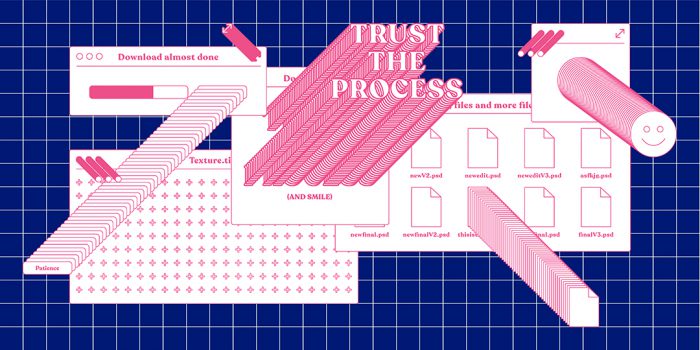Should I Get a Master’s Degree in Graphic Design? Here’s Everything You Need to Know

Being a master of something always sounds pretty great. A Jedi Master, Master of Ceremonies, a masterpiece. But did you know you can become a Master of Graphic Design? That’s right, if you get a Master’s degree in graphic design then you could be just that or, more precisely, you would hold a Master of Arts (MA) in graphic design. Master’s degrees have been around since the 18th Century and remain popular to this day and a Master’s in graphic design or a related field has been an option since the late 20th Century.
A Master’s Degree in graphic design by name alone sounds like an attractive option for many students to take, but if you’re pondering “should I get a Master’s Degree in graphic design?” then we’re here to help. We’re going to consider their usefulness in 2021 to help you make an informed decision about whether or not to embark on further study to help you become a graphic designer.
We’ll also mention quickly before we get started—if your main goal of extra study is to get a more-fulfilling or better-paying job as fast as possible, definitely consider your alternatives! Shillington is just what you’re looking for—a fast-paced intensive graphic design course, which gets you fully equipped to work in the industry.
Are Masters Degrees In Graphic Design Still Useful?
First of all, we should explain exactly what a Master’s Degree is so that you can fully understand what you would be taking on if you choose to study for an MA to learn graphic design. A Master’s Degree is a postgraduate degree, which means that to study on a program you will have to have an undergraduate degree (or Bachelor’s Degree) or a graphic design certificate, usually in a related field of study, in order to enrol.
There are two separate kinds of Master’s Degrees—Taught or Research. They both do exactly what they say on the tin. Taught Master’s Degrees are much like an undergraduate degree, where you’ll complete modules through seminars, lectures, studio time and more but with much more independence. A majority of the Taught courses last a year if you take them full-time, though some do last two years. Research Master’s Degrees are even more independent and focus on just one or two projects for the duration of the course, which you would undertake the research with guidance from a supervisor. These generally, if taken full-time, take two years to complete. Make sure you know what kind of Master’s you are applying for—you don’t want any surprises!
But, why do people do a Master’s?
Well, Master’s Degrees are effectively a way of specialising in a field of study, whether this be more generalised or more specific. In the instance of graphic design, you can do a Master’s in graphic design itself or in something more specific within the field.
A quick Google reveals Master’s courses in visual communication design, motion graphics and titles, advertising and design, typography, digital design and loads more.
With this in mind, it would not only be unfair but just plain wrong to suggest that Master’s Degrees in graphic design are not useful. They’re a great way for student designers to further their studies or specialise in one particular area of design. On top of this, education is never a bad thing! If someone wants to continue their studies, then that should always be encouraged. So, if you’re still thinking, should I get a Master’s Degree in graphic design? Then the choice is yours! If you’ve read that with wide eyes, then you can probably guess what the answer is.
Next, we’re going to take a look at the different career options and potential salary that comes with a Master’s Degree in graphic design to help you further weigh up your options.
Career Options
Obviously one of the main pulls of a Master’s Degree and postgraduate education in general is the position it will put you in with potential employers. Will they look upon your Master’s fondly or would they just be happy if you had a portfolio full of design work from a Bachelor’s Degree or another course? We will also breakdown the different career options that a Master’s Degree in graphic design or a more specific related field will open up for you.
It’s no secret that anyone’s key to the graphic design industry is a great portfolio.
There’s a high chance that when you apply for a job that the person employing isn’t looking through a stack of CVs to see whether you have a Master’s—or even a Bachelor’s Degree—it’s a stack of portfolios they’re looking at.
They want to see what you can do and whether it fits right with the company. Your portfolio should, therefore, be a demonstration of your best graphic design skills and work.
This might make you question what the point of a Master’s Degree in graphic design is, but the answer should be clear. A Master’s Degree in graphic design or a specific related field like digital design is going to help you develop and improve your portfolio. It’s a great way of making your portfolio more focused on the kind of work you want to work on.
In terms of career options, if you call yourself a graphic designer then you aren’t just limited to being a graphic designer. There’s lots of different career routes you could take—from a UI/UX designer to a book cover designer. If there is something specific you’re looking to get into then a Master’s could be the way forward. For instance, if you want to become a UI/UX designer (that’s user interface and user experience if you didn’t know) then you’re going to want to have a decent knowledge of digital design and a portfolio that reflects that. Consequently, if you do want to become a UI/UX designer then a Master’s in digital design could be a very interesting prospect.
It’s important to note that a Master’s Degree might not necessarily widen your scope of career options—it could do the opposite. Though, we’re not saying this is a bad thing. If after your undergraduate graphic design degree or another alternative graphic design course, you find that you’re especially interested in working in one area of graphic design then a Master’s Degree in that area could seriously help on your way to a job in that area.
In summary, a Master’s Degree in graphic design is not a sure fire way to get a job in the graphic design industry. This is more dependent on your portfolio. Which can open you up to any number of different roles: freelance graphic designer, packaging designer, book cover designer, digital or UX/UI designer and loads more. But, a Master’s Degree can help you to define what you want to do and refine your portfolio to help you find the perfect job for you.
Salary Potential
We’re sure it comes as no surprise to you that universities and colleges aren’t just giving away Master’s Degrees in graphic design—they do come at a cost and they’re not cheap. The average cost of a Master’s in the US is between $30,000 and £120,000, while in the UK it is £8,407 and between AU$20,000 and AU$37,000 in Australia. Pretty pricey, right? Though if you do decide to do a Master’s Degree in graphic design then you’ll really want to be thinking about how much you’re going to earn as a result of that degree—and not just because you’re going to be paying back those student loans.
So, what is your potential salary as a graphic designer once you graduate from a Master’s? Let’s talk a look to help you think about whether you should get a Master’s Degree in graphic design.
According to Indeed, in the USA in January 2021 a junior designer, which tends to be the first step that graduates take after university, could expect to earn an average base salary of $40,096 a year. This then increases to $59,241 a year as you progress to a senior designer and finally reaches $111,363 as a design director.
Meanwhile in the UK, the average base salary for a junior designer is £20,701, for a senior is £33,638 and for a design director is £63,630.
Finally, in Australia, the average base salary for a junior designer is $53,846, for a senior is $88,204 and for a design director is $153,579.
These potential salaries are definitely something to consider when deciding whether or not you want to study for a Master’s in graphic design—especially when you factor student debt into the equation.
Though, it’s important to remember that a Master’s is likely to help you build a better and potentially more specific portfolio, which in term might help you get progress through the industry further or gain a more specific, better paid job. For example, the average base salary for a digital designer is $91,516, £33,305 and $101,402 in the US, UK and Australia respectively—a clear jump from that of a junior graphic designer. Which brings us on to our next point…
How Long Will It Take To Earn?
We’ve told you how long a Master’s Degree in graphic design will take, outlined how much it will cost and how much you could earn, but this leaves one big question—how long will it take to start earning that much?
Well first of all it must be noted that a career in graphic design is not always a linear path from graduate to junior to mid-weight to senior. Obviously it can be, but there can also be lots of twists and turns along the way or you can bypass that entirely and go straight into freelancing and working for yourself. Or you could work in-house for a company. Or you could combine all three and start off as a freelancer, before going into a role in a design agency and then ending up as a design director internally for a company. The path you take is up to one person—you! And it goes without saying that choosing whether or not to do a Master’s Degree in graphic design is part of this personal path of design discovery.
For the sake of this article however, let’s pretend that you are taking the linear path out of your Master’s Degree in graphic design. Most graduates will be at the position of junior graphic designer, these positions are held for designers who have no experience outside of internships, their own freelancing and college work. From six months to two years after this, juniors can expect to make the jump to straight graphic designer, which also comes with a jump in salary.
As a graphic designer with a Master’s degree, you may be able to apply for these graphic designer roles as soon as you graduate, skipping the junior level altogether.
The next step up is middleweight or mid-weight graphic designer, which again comes with the increase in salary we outlined above. This usually takes a few years to progress to this level, but progression is definitely more about your own achievements rather than simply being about the length of time you’ve been working for. By this time, your portfolio will look a whole lot different than when you graduated. Given this, looking at the average salaries above, you could be earning a decent wage just a few years out from your graphic design Master’s.
From there on out, you’ll be looking to the top—at senior designer and art director roles and finally the position of creative director. These roles are all about the amazing work you can create—so there’s no distinct progression times for them, you can’t just sit around doing nothing for several years and expect to walk into the top roles.
To summarise, how long will it take to earn? How long is a piece of string? You’ve seen the earning potential after graduating from a Master’s Degree in graphic design, but how you get there is now up to you. It’s all dependent on the type of roles you want to apply for, the type of company you want to work in, the work you produce and many other factors.
Are There Better Alternatives?
We hope we’ve given you a decent overview of why a Master’s Degree in graphic design is a great way of starting your design career or furthering your existing design education, but is there another way? You bet there is! Shillington allows you to become a graphic designer, graduating with a polished portfolio and all the skills and knowledge you need to head out into the design industry—everything from the very principles of design onwards. Oh and the best bit? Shillington’s innovative graphic design course does that in three months full-time or nine months part-time.
Being taught by experienced, talented practicing designers in a studio environment means that Shillington graduates are able to seamlessly transition from student to studio and immediately start working as a graphic designer. The affordable course fees and multiple enrolments a year mean that that dream job as a graphic designer is closer than you could imagine.
We hope this has given you an understanding of Master’s Degrees in graphic design and other design-related fields—hopefully you’re a bit closer to being able to answer that question “should I get a Master’s Degree in graphic design?”. Through this article, we’ve explained how useful a graphic design Master’s is in the modern world and how it can help you—in terms of career options, salary and progression in the industry. And, in short, it can be useful and it can help you, but it does depend on what you want to do and what you do with what you learn on a Master’s. We’ve also told you there is a potentially better alternative if you do want to become a graphic designer—Shillington’s innovative, all-encompassing graphic design course. Read more about Shillington’s course and enrol, here.
Want to win some amazing prizes and stay in the loop with all things Shillington? Sign up to our newsletter to automatically go in the draw.







